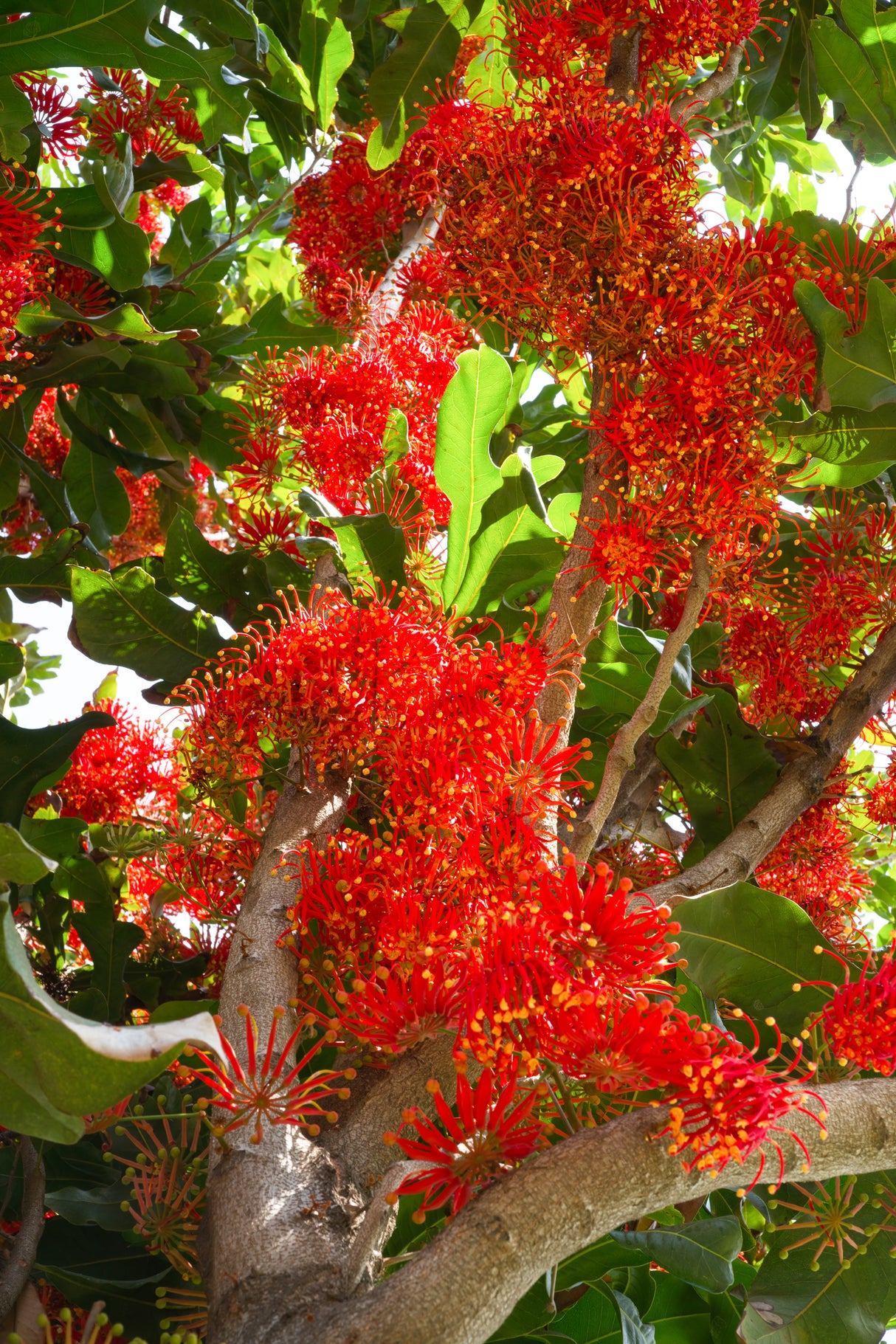Stenocarpus sinuatus – Firewheel Tree
The Stenocarpus sinuatus, commonly known as the Firewheel Tree, is an iconic Australian native tree admired for its vibrant, wheel-shaped orange-red flowers and glossy dark green foliage. Flowering in summer and autumn, this evergreen tree is a striking addition to gardens, parks, and streetscapes. Its symmetrical growth and low-maintenance nature make it a versatile and visually stunning choice for both ornamental and practical landscaping.
Specifications:
- Height: 10–30 meters (smaller in cultivation)
- Width: 5–10 meters
- Native to: Australia (rainforests of New South Wales and Queensland)
- Foliage: Glossy, dark green leaves; evergreen
- Growth rate: Slow to moderate
Conditions:
- Soil: Prefers well-drained soils; tolerates sandy, loamy, and clay conditions
- Light: Full sun to partial shade
- Water: Moderate; drought-tolerant once established
- Climate: Thrives in temperate, subtropical, and tropical regions
Additional Features:
- Flowers: Unique, wheel-shaped, orange-red blooms in summer and autumn, attracting pollinators
- Form: Symmetrical growth with a dense, rounded canopy
- Uses: Ideal as a feature tree, street planting, or in large gardens and parks
- Spacing: Plant 5–10 meters apart for individual specimens or closer for avenues
- Low Maintenance: Requires minimal pruning; remove deadwood to maintain appearance
- Pest Resistance: Generally pest-free and hardy
- Drought Tolerance: Moderate; benefits from supplemental watering during prolonged dry spells
- Frost Sensitivity: Protect from heavy frost in cooler regions
- Wildlife Attraction: Flowers attract bees, birds, and butterflies; provides habitat for native fauna
- Seasonal Appeal: Evergreen foliage with dramatic seasonal flowers
- Timber Use: Valued for its attractive, durable wood in cabinetry and flooring
- Cultural Significance: Native to Australian rainforests, contributing to biodiversity
The Firewheel Tree is a stunning and durable tree that brings year-round greenery and seasonal bursts of color to landscapes. Its unique flowers and easy-care nature make it a standout choice for enhancing outdoor spaces.
The Benefits Of Buying An Advanced Tree
The Process Of Transplanting A Mature Tree
Identify the Tree's Root Zone
Identify the Tree's Root Zone
Before you begin, it's essential to identify the root zone or root ball of the tree. This is the area where the majority of the tree's feeder roots are located. It is typically estimated as 1 foot of root ball diameter for each inch of tree trunk diameter.
Prune the Roots
Prune the Roots
Root pruning should occur a few months before the actual move, ideally in the dormant season. This involves cutting a trench around the root zone to encourage the growth of new feeder roots, which will help the tree to establish itself in its new location.
Prepare the Tree
Prepare the Tree
Prior to digging, prune dead or excessive branches from the tree. This reduces the tree's overall mass, making it easier to handle, and decreases water loss post-transplant.
Dig Around the Root Ball
Dig Around the Root Ball
After determining the root ball's size, begin digging around it. Try to retain as much soil around the roots as possible. The depth should ideally get under the root system but be feasible for lifting.
Undercut the Root Ball
Undercut the Root Ball
Once you've dug around the periphery of the root ball, begin undercutting to sever the remaining roots beneath it.
Lift the Tree
Lift the Tree
With the root ball freed, carefully lift the tree out of the hole. For large trees, this will likely require machinery like a tree spade or crane. Always lift the tree by the root ball, not the trunk.
Prepare the Tree for Transport
Prepare the Tree for Transport
Once the tree is out of the ground, it's critical to protect the root ball to prevent damage. Wrap it in burlap and secure it with twine, wire or steel basket. This not only holds the root ball together but also helps retain moisture.
Water the Root Ball
Water the Root Ball
Prior to transportation, water the root ball thoroughly to ensure the roots stay moist.
Transporting the Tree
Transporting the Tree
Load the tree carefully onto a truck or trailer for transport. The tree should be securely positioned to avoid damage during transit. The tree should ideally be planted in its new location as soon as possible to minimize stress and increase its chance of survival.


